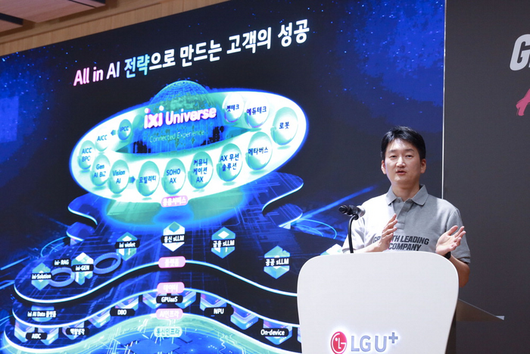 |
[Courtesy of LG Uplus Corp.] |
<이미지를 클릭하시면 크게 보실 수 있습니다> |
LG Uplus unveiled a bold vision to target 2 trillion won ($1.44 billion) in revenue by 2028 in the business-to-business (B2B) sector via the advancement of artificial intelligence (AI) services. To realize this goal, the company plans to launch AI semiconductors within 2024 and develop small language models (sLLMs) tailored for various industries such as finance and security.
During a press conference held at its headquarters in Seoul on Tuesday, LG Uplus revealed its AI-centric B2B mid-to-long-term growth strategy, “All in AI.” The strategy focuses on enhancing AI application services by concentrating on technological innovations in infrastructure, platforms, and data.
Central to the infrastructure plan is the data center business, which aims to implement next-generation cooling technologies to ensure server stability and energy efficiency. LG Uplus is set to develop an AI data center in Paju, Gyeonggi Province, the third hyperscale data center in its portfolio. It will also leverage its proprietary sLLM, ixi-GEN, to enhance the operational efficiency of enterprise AI servers.
In the on-device AI sector, LG Uplus is collaborating with local semiconductor design company DEEPX to introduce AI semiconductors integrated with ixi-GEN by the end of 2024. This on-device AI technology will be applied not only in its own business sectors such as telecommunications equipment, AI Contact Centers (AICC), small office/home office (SOHO), robots, and mobility but also across various devices owned by LG Group affiliates.
For the platform and data sectors, LG Uplus aims to differentiate itself with the B2B-specific AI solution “ixi Enterprise,” based on ixi-GEN. ixi Enterprise is composed of three AI transformation (AX) platforms: ixi Solution, which helps enterprises update and manage AI services tailored to their needs; U+ Data Lake, a data management platform; and Violet, a machine learning operations platform that automates the entire process from AI development to training.
이 기사의 카테고리는 언론사의 분류를 따릅니다.
기사가 속한 카테고리는 언론사가 분류합니다.
언론사는 한 기사를 두 개 이상의 카테고리로 분류할 수 있습니다.
언론사는 한 기사를 두 개 이상의 카테고리로 분류할 수 있습니다.


